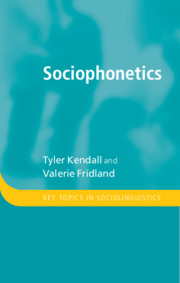24 results
8 - Sociophonetics and Its Methodological Future
-
- Book:
- Sociophonetics
- Published online:
- 26 February 2021
- Print publication:
- 11 March 2021, pp 178-207
-
- Chapter
- Export citation
5 - Sociophonetics and Social Factors
-
- Book:
- Sociophonetics
- Published online:
- 26 February 2021
- Print publication:
- 11 March 2021, pp 96-125
-
- Chapter
- Export citation
Copyright page
-
- Book:
- Sociophonetics
- Published online:
- 26 February 2021
- Print publication:
- 11 March 2021, pp iv-iv
-
- Chapter
- Export citation
2 - Sociophonetics and Its Methods
-
- Book:
- Sociophonetics
- Published online:
- 26 February 2021
- Print publication:
- 11 March 2021, pp 12-39
-
- Chapter
- Export citation
Index
-
- Book:
- Sociophonetics
- Published online:
- 26 February 2021
- Print publication:
- 11 March 2021, pp 254-258
-
- Chapter
- Export citation
3 - Sociophonetics and Its Methods
-
- Book:
- Sociophonetics
- Published online:
- 26 February 2021
- Print publication:
- 11 March 2021, pp 40-72
-
- Chapter
- Export citation
1 - Sociophonetics = Sociolinguistics + Phonetics
-
- Book:
- Sociophonetics
- Published online:
- 26 February 2021
- Print publication:
- 11 March 2021, pp 1-11
-
- Chapter
- Export citation
9 - In Closing
-
- Book:
- Sociophonetics
- Published online:
- 26 February 2021
- Print publication:
- 11 March 2021, pp 208-213
-
- Chapter
- Export citation
Acknowledgments
-
- Book:
- Sociophonetics
- Published online:
- 26 February 2021
- Print publication:
- 11 March 2021, pp xviii-xx
-
- Chapter
- Export citation
Contents
-
- Book:
- Sociophonetics
- Published online:
- 26 February 2021
- Print publication:
- 11 March 2021, pp v-vii
-
- Chapter
- Export citation
6 - Sociophonetics, Style and Identity
-
- Book:
- Sociophonetics
- Published online:
- 26 February 2021
- Print publication:
- 11 March 2021, pp 126-155
-
- Chapter
- Export citation
References
-
- Book:
- Sociophonetics
- Published online:
- 26 February 2021
- Print publication:
- 11 March 2021, pp 214-253
-
- Chapter
- Export citation
Preface
-
- Book:
- Sociophonetics
- Published online:
- 26 February 2021
- Print publication:
- 11 March 2021, pp xi-xvii
-
- Chapter
- Export citation
Figures
-
- Book:
- Sociophonetics
- Published online:
- 26 February 2021
- Print publication:
- 11 March 2021, pp viii-x
-
- Chapter
- Export citation
4 - Sociophonetics and Regional Variation
-
- Book:
- Sociophonetics
- Published online:
- 26 February 2021
- Print publication:
- 11 March 2021, pp 73-95
-
- Chapter
- Export citation
7 - Sociophonetics and Sound Change
-
- Book:
- Sociophonetics
- Published online:
- 26 February 2021
- Print publication:
- 11 March 2021, pp 156-177
-
- Chapter
- Export citation

Sociophonetics
-
- Published online:
- 26 February 2021
- Print publication:
- 11 March 2021
7 - Regional Identity and Listener Perception
- from Part I - Language Regard: Varied Methods
-
-
- Book:
- Language Regard
- Published online:
- 12 January 2018
- Print publication:
- 18 January 2018, pp 132-150
-
- Chapter
- Export citation
Regional relationships among the low vowels of U.S. English: Evidence from production and perception
-
- Journal:
- Language Variation and Change / Volume 29 / Issue 2 / July 2017
- Published online by Cambridge University Press:
- 25 July 2017, pp. 245-271
- Print publication:
- July 2017
-
- Article
- Export citation
Chapter 13 - Western United States
-
-
- Book:
- Listening to the Past
- Published online:
- 21 July 2017
- Print publication:
- 20 April 2017, pp 325-349
-
- Chapter
- Export citation



